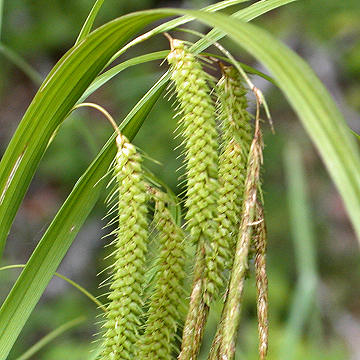

Carex crinita - (image 1 of 4)
Taxonomy
Family: Cyperaceae
Section Phacocystis
Habitat
Peaty marshes, wet woods, swales, moist thickets.
Associates
Distribution
Newfoundland and Quebec west to MN, south to GA and TX.
Morphology
Tufted, perennial to 1.6 m; stems sharp-angled and rough, exceeding the leaves, lower leaves scale-like. Leaves 4-12 mm wide with rough margins; sheaths glabrous; staminate spikes 2-3, terminal, 4-6 cm long, sometimes pistillate distally; pistillate spikes 2-6, thin, nodding, long-awned, up to 10 cm long; perigynia obovoid, sometimes inflated, 2-4 mm long, a little longer than wide, unnerved with a pointed tip; scales coppery with a pale midrib extending into a long, flat awn exceeding the perigynia.
Notes
Fruiting June to August
Wetland indicator: OBL
Recognized for the slender, nodding spikelets and long awns that exceed the perigynia. Most readily distinguished from the similar C. gynandra by the smooth lower portion of the culm (in C. gynandra the lower part of the culm is scabrous to the touch). There are two varieties, var. crinita with ellipsoid to obovoid perigynia and variously constricted achenes, and var. brevicrinis with broadly obovoid perigynia and achenes that are not constricted.
References
Ball, P.W. and A.A. Reznicek. 2002. Carex, In: Flora of North America Editorial Committee, Eds. Flora of North America North of Mexico. Volume 23. Oxford University Press, New York.
Curtis, L. 2006. Woodland Carex of the upper Midwest. Lake Villa, IL.
Gleason, Henry A. and A. Cronquist. 1991. Manual of Vascular Plants of
Northeastern United States and Adjacent Canada. Second Ed.
The New York Botanical Garden. Bronx, NY
Swink, F. and G. Wilhelm. 1994. Plants of the Chicago Region.
Indiana Academy of Science. The Morton Arboretum. Lisle, Illinois.
|
© Michael Hough 2009 |